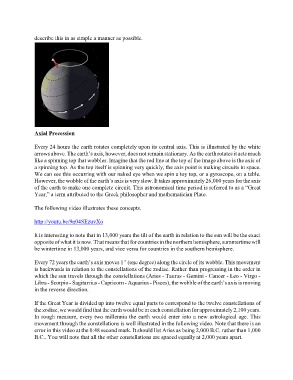Page 224 - Foundations
P. 224
describe this in as simple a manner as possible.
Axial Precession
Every 24 hours the earth rotates completely upon its central axis. This is illustrated by the white
arrows above. The earth’s axis, however, does not remain stationary. As the earth rotates it acts much
like a spinning top that wobbles. Imagine that the red line at the top of the image above is the axis of
a spinning top. As the top itself is spinning very quickly, the axis point is making circuits in space.
We can see this occurring with our naked eye when we spin a toy top, or a gyroscope, on a table.
However, the wobble of the earth’s axis is very slow. It takes approximately 26,000 years for the axis
of the earth to make one complete circuit. This astronomical time period is referred to as a “Great
Year,” a term attributed to the Greek philosopher and mathematician Plato.
The following video illustrates these concepts.
http://youtu.be/9n04SEzuvXo
It is interesting to note that in 13,000 years the tilt of the earth in relation to the sun will be the exact
opposite of what it is now. That means that for countries in the northern hemisphere, summertime will
be wintertime in 13,000 years, and vice versa for countries in the southern hemisphere.
Every 72 years the earth’s axis moves 1E (one degree) along the circle of its wobble. This movement
is backwards in relation to the constellations of the zodiac. Rather than progressing in the order in
which the sun travels through the constellations (Aries - Taurus - Gemini - Cancer - Leo - Virgo -
Libra - Scorpio - Sagitarrius - Capricorn - Aquarius - Pisces), the wobble of the earth’s axis is moving
in the reverse direction.
If the Great Year is divided up into twelve equal parts to correspond to the twelve constellations of
the zodiac, we would find that the earth would be in each constellation for approximately 2,100 years.
In rough measure, every two millennia the earth would enter into a new astrological age. This
movement through the constellations is well illustrated in the following video. Note that there is an
error in this video at the 0:48 second mark. It should list Aries as being 2,000 B.C. rather than 1,000
B.C.. You will note that all the other constellations are spaced equally at 2,000 years apart.

